

Lift (force) Lift is the force generated by propellers and wings to propel aircraft and keep them in the air.
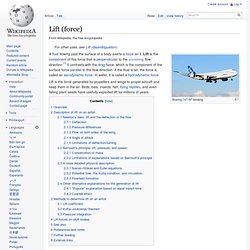
Birds, bats, insects, fish, flying reptiles, and even falling plant seeds have usefully exploited lift for millions of years. Forces on an airfoil An airfoil is a streamlined shape that is capable of generating significantly more lift than drag.[4] Non-streamlined objects such as bluff bodies and flat plates may also generate lift when moving relative to the fluid, but will have a higher drag coefficient dominated by pressure drag.[5] There are several ways to explain how an airfoil generates lift. Some are more complicated or more mathematically rigorous than others; some have been shown to be incorrect.[6][7][8][9][10] For example, there are explanations based directly on Newton’s laws of motion and explanations based on Bernoulli’s principle.
Streamlines around an airfoil in a wind tunnel. The air changes direction as it passes the airfoil and follows a path that is curved. IRROTATIONAL FLOW OF AN INVISCID FLUID. Diese Abhandlung befaßt sich mit wirbelfreien Strömungen eines nichtviskosen Fluids in der Ebene (Wenn im folgenden von Fluid die Rede ist, so ist damit entweder eine Flüssigkeit oder ein Gas bzw.
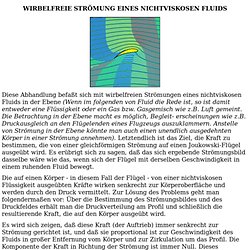
Gasgemisch wie z.B. Luft gemeint. Die Betrachtung in der Ebene macht es möglich, Begleit- erscheinungen wie z.B. Druckausgleich an den Flügelenden eines Flugzeugs auszuklammern. Anstelle von Strömung in der Ebene könnte man auch einen unendlich ausgedehnten Körper in einer Strömung annehmen). Die auf einen Körper - in diesem Fall der Flügel - von einer nichtviskosen Flüssigkeit ausgeübten Kräfte wirken senkrecht zur Körperoberfläche und werden durch den Druck vermittelt.
Es wird sich zeigen, daß diese Kraft (der Auftrieb) immer senkrecht zur Strömung gerichtet ist, und daß sie proportional ist zur Geschwindigkeit des Fluids in großer Entfernung vom Körper und zur Zirkulation um das Profil. Zurück zur Titelseite. Fliegen kurzgefasst. Physik des Fliegens in einer knappen Darstellung Auftrieb und Gewicht.

Ballone und Luftschiffe halten sich in der Luft oder steigen auf, weil Ihr Gewicht gleich groß oder kleiner ist als das Gewicht der Luft, die sie verdrängen. Diese Kraft wird statischer Auftrieb genannt, weil sie auch dann wirkt, wenn Luft und Fluggerät relativ zueinander in Ruhe sind. Vögel und Flugzeuge sind viel schwerer als die Luft, die sie verdrängen. Ihr Gewicht ist so groß, dass neben dem statischen Auftrieb eine weitere Gegenkraft erforderlich ist, die sie in der Luft hält. EASA - Certification Specifications. The Agency has consulted interested parties on Certification Specifications in accordance with the provisions of the rulemaking procedure.
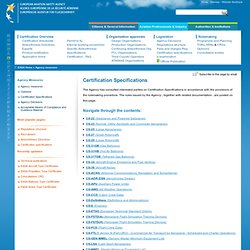
The rules issued by the Agency , together with related documentation , are posted on this page. Navigate through the contents: CS-22 (Sailplanes and Powered Sailplanes) Current Issue CS-22/Initial Issue (14/11/2003) CS-23 (Normal, Utility, Aerobatic and Commuter Aeroplanes) CS-23/2 Corrigendum (28/09/2010) CS-23/Initial Issue (14/11/2003) NASA Technical Reports Server. SWR Warum? Fliegen 4 / 1. Reisen mit dem Flugzeug sind heute nichts Außergewöhnliches mehr.
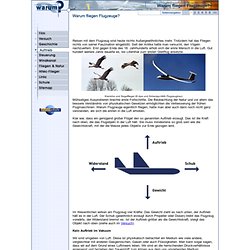
Trotzdem hat das Fliegen nichts von seiner Faszination eingebüßt. Seit der Antike hatte man versucht, den Vögeln nachzueifern. Erst gegen Ende des 18. Jahrhunderts erhob sich der erste Mensch in die Luft. Gut hundert weitere Jahre dauerte es, bis Lilienthal zum ersten Gleitflug ansetzte. Kraniche und Segelflieger (© dpa und Schempp-Hirth Flugzeugbau) Mühseliges Ausprobieren brachte erste Fortschritte. Klar war, dass ein genügend großer Flügel den so genannten Auftrieb erzeugt. Im Wesentlichen wirken am Flugzeug vier Kräfte: Das Gewicht zieht es nach unten, der Auftrieb hält es in der Luft.
Kein Auftrieb im Vakuum. Flugtheorie.de. Bernoulli and Newton. How do wings work? - Supplementary data - Physics Education. Incorrect Lift Theory. There are many theories of how lift is generated.
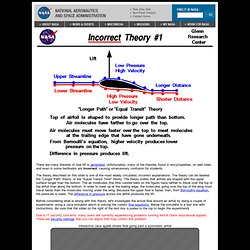
Unfortunately, many of the theories found in encyclopedias, on web sites, and even in some textbooks are incorrect, causing unnecessary confusion for students. The theory described on this slide is one of the most widely circulated, incorrect explanations. The theory can be labeled the "Longer Path" theory, or the "Equal Transit Time" theory. The theory states that airfoils are shaped with the upper surface longer than the bottom. The air molecules (the little colored balls on the figure) have farther to travel over the top of the airfoil than along the bottom. Before considering what is wrong with this theory, let's investigate the actual flow around an airfoil by doing a couple of experiments using a Java simulator which is solving the correct flow equations.
Due to IT security concerns, many users are currently experiencing problems running NASA Glenn educational applets. Activities: Guided Tours Theories of Lift: Navigation ..